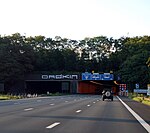Middelheim Open Air Sculpture Museum (Dutch Beeldentuin Middelheim Museum) is a sculpture park of 30 acres in the park part of the Middelheim Nachtegalen Park at Antwerp. The Middelheim Museum collection has approximately 400 works of art on display. These include around 215 sculptures, featuring artists such as Carl Andre, Franz West, Auguste Rodin and many more. Along with the addition of new works every year, the museum invites contemporary artists to engage in an artistic conversation with works part of the permanent collection and the environment surrounding them, leading to the establishment of performances and exhibitions and by various kinds of artists. Works such as ones by Roman Signer and Ai Weiwei are also created specifically for the museum. (“Middelheim Museum”)
The museum includes the Braem pavilion, designed by the Belgian architect Renaat Braem. He is seen as a significant symbol for post-war architecture in Belgium and aimed to blur the boundaries between architecture and art. Reflective of this, Braem aimed to design the pavilion to incorporate a sculptural quality to organically merge it with the park’s landscape. The design developed into a set of closed pavilions and open patios, formulated “as nature would”, with an accessible entrance and a distinct roof structure to create an ever-changing spatial experience augmented by the flow of light through the pavilion. The rudimentary base was placed in 1969, and the pavilion was then officially introduced at the eleventh Biennial in 1971. Plans for construction around the pavilion were left unfinished with a fountain by Olivier Strebelle being the only trace, which speaks to the idea of merging architecture with nature as it embraces the idea of imperfection. (“The Braem Pavilion”) Another fountain by the Belgian artist Philippe Van Snick is placed in front of the pavilion. (“Middelheim Museum”)
The Braem Pavilion is exclusive to fragile works from the permanent collection, such as ones by Alberto Giacometti, Jean Arp, and Wim Delvoye, to maintain them suitably. The works exhibited at the pavilion change twice a year. (“Middelheim Museum”)
A 750-meter pathway begins at the Braem Pavilion and runs past the Middelheim Castle and over Middelheimlaan to ‘Hortiflora’, a botanical flower garden part of Nachtegalenpark until it was added to the Middelheim Museum in 2012. With this inclusion, the museum covers more than thirty hectares of park and exhibition area. (“Middelheim Museum”)
The merging of art and nature is a significant aspect of the museum. This is seen through the displayed works, the kinds of exhibitions curated and the pavilions and structure of the open-aired museum itself. In the works exhibited, their placement is just as important as the works themselves because the intermingling of the works with their natural surroundings transforms and augments the experience of the viewer.










